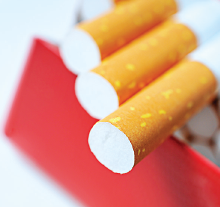Journal Digest
U.S. Public Supports Raising Age to Purchase Tobacco

The majority of U.S. residents are in favor of raising the legal minimum age to purchase tobacco products, according to a study published last month in the American Journal of Prevention Medicine.
Researchers from the University of North Carolina analyzed data from a national telephone survey conducted from September 2014 to May 2015 that asked 4,880 adults 18 and older to indicate their support for policies that would increase the legal age for purchasing tobacco products from 18 to 19, 20, or 21.
While the level of support for raising the minimum age of sale for tobacco products varied slightly by geographical regions, the authors found overall 66 percent of the adults were in favor of the policy change. Odds of support for raising the minimum sales age to 21 trended higher than support for raising the age to 19 or 20 years.
“Both this work and previous research suggest that federal legislative action to raise the minimum age of tobacco sales would be well received by the public,” the researchers wrote. “Policymakers should be aware that linking policy changes to trusted government agencies may facilitate adoption of policies that reduce tobacco use.”
Lee J, Boynton M, Richardson A, et al. Raising the Legal Age of Tobacco Sales: Policy Support and Trust in Government, 2014-2015, U.S. Am J Prev Med. May 20, 2016. [Epub ahead of print]
Over 2 Million College Students Use Alcohol or Marijuana Daily

Over 2 million college students in the United States use alcohol or smoke marijuana each day, according to a recent report by the Substance Abuse and Mental Health Services Administration (SAMHSA).
The findings of the report were based on combined data from the 2011 to 2014 National Survey on Drug Use and Health (NSDUH). As part of the NSDUH, college students aged 18 to 22 were asked about their past year and past month use of alcohol and illicit drugs, which includes nine categories: marijuana, cocaine (including crack), heroin, hallucinogens, and inhalants, as well as the nonmedical use of prescription-type pain relievers, tranquilizers, stimulants, and sedatives.
The results showed that on an average day in the past year, 1.2 million full-time college students drank alcohol, and 703,759 smoked marijuana. A total of 239,212 part-time college students engaged in alcohol use, and 195,020 smoked marijuana.
The report also found that on an average day in the past year, 2,179 full-time college students drank alcohol for the first time, and 1,299 used marijuana. As for part-time college students, 453 drank alcohol for the first time and 153 started using marijuana.
“Substance misuse at any age can jeopardize one’s health and long-term well-being, but college students may be particularly at risk because of the pressures they face at this critical juncture of their lives,” SAMHSA’s Center for Substance Abuse Prevention Director Frances Harding said in press release. “College administration, faculty, and staff; students; parents; and the surrounding community must work to ensure that college students get the effective prevention programming and treatment services they need.”
A Day in the Life of College Students Aged 18 to 22: Substance Use Facts. The CBHSQ Report. May 26, 2016.
Exposure to Chemo Early in Life May Alter Executive Function

Higher exposure to the chemotherapy drug methotrexate appears to be associated with long-term executive dysfunction in survivors of childhood acute lymphoblastic leukemia, according to a study published in the Journal of Clinical Oncology.
Researchers at St. Jude Children’s Research Hospital recruited over 200 pediatric patients, who were at least five years post-diagnosis and had been treated with chemotherapy, to perform a series of cognitive and neuroimaging tests. The researchers then compared pharmacokinetic assays collected during therapy with neurocognitive and brain imaging outcomes.
While overall intelligence of the survivors was within the normal range, measures of executive function, processing speed, and memory were lower in survivors than population means. Higher plasma methotrexate was also associated with neurological changes associated with executive function, such as thicker cortices in dorsolateral prefrontal brain regions.
“With five-year survival rates for pediatric ALL [acute lymphoblastic leukemia] approaching 95 percent, researchers are focused on better understanding and reducing the neurotoxicity patients still experience during and sometimes long after treatment,” said lead study author Kevin Krull, Ph.D., in a statement. “It remains a relatively common problem even in the contemporary treatment era of chemotherapy only.” ■
Krull K, Cheung Y, Liu W, et al. Chemotherapy Pharmacodynamics and Neuroimaging and Neurocognitive Outcomes in Long-Term Survivors of Childhood Acute Lymphoblastic Leukemia. J Clin Oncol. June 6, 2016. [Epub ahead of print]



